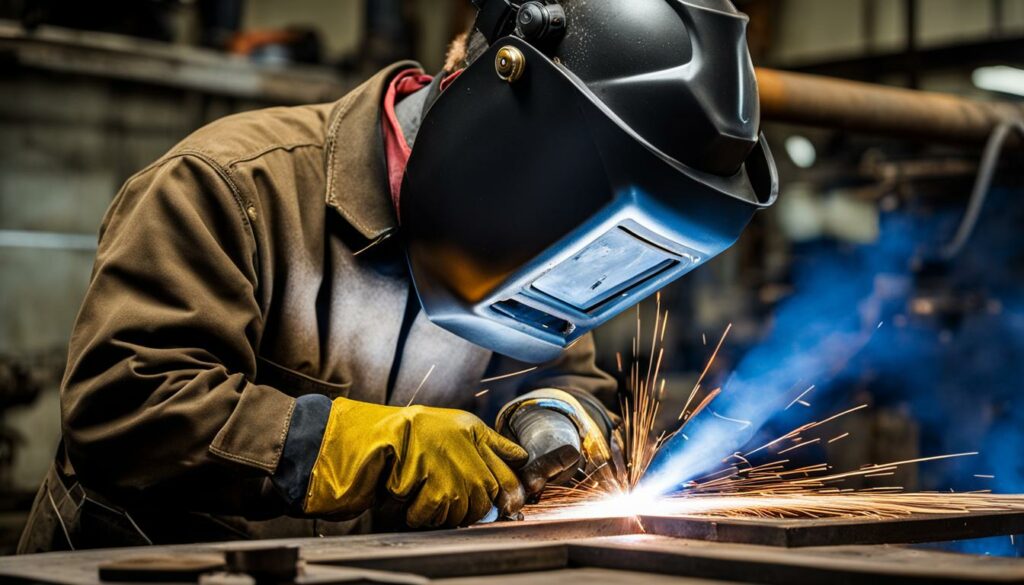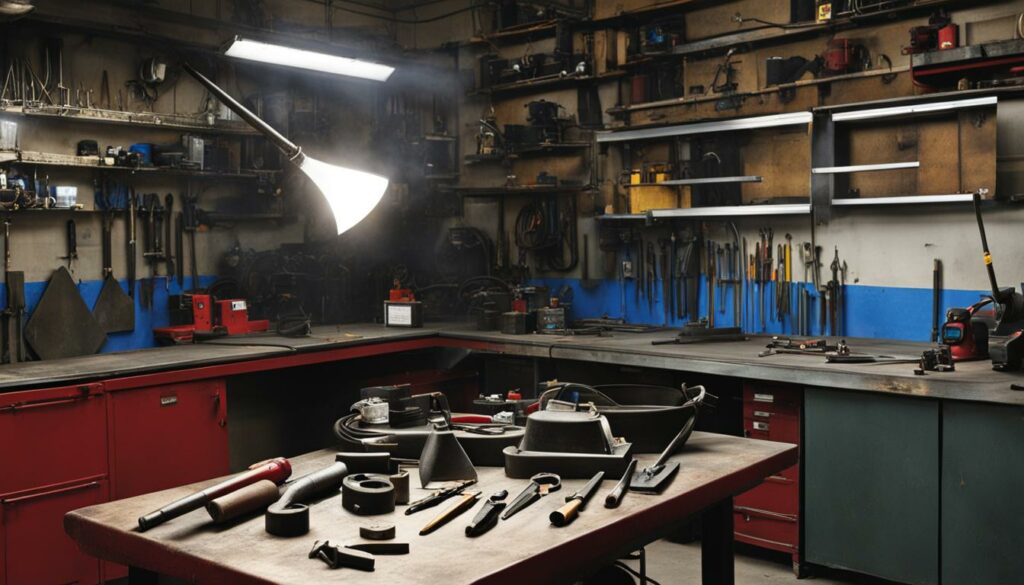Our beginner welding repair guides will equip you with the essential knowledge and skills needed to tackle your first welding project with confidence. Whether you’re a hobbyist looking to learn a new skill or considering welding as a potential career path, our comprehensive guides will provide you with step-by-step instructions and practical tips to ensure your success. From setting up your welding studio to learning the different welding techniques, safety precautions, and essential tools and equipment, our guides cover all the basics you need to know to get started in welding. With our help, you’ll be able to build, repair, and create with ease and precision. Make your first welding project a success with our beginner welding repair guides.
Key Takeaways:
- Our beginner welding repair guides provide step-by-step instructions and practical tips for success.
- Whether you’re a hobbyist or considering welding as a career, our guides cover all the basics you need to know.
- From setting up your welding studio to mastering the different techniques, our guides equip you with the knowledge and skills to create with confidence.
- Safety precautions are crucial when welding, and our guides highlight the necessary measures to protect yourself and others.
- Having the right tools and equipment is essential, and our guides help you understand what you need and how to use them.
Understanding Different Welding Techniques
As a beginner in welding, it’s essential to grasp the fundamentals of different welding techniques. Each technique has its own unique advantages and applications, allowing you to choose the most suitable one for your specific welding project. By understanding these techniques, you can lay a solid foundation in welding basics and enhance your welding skills.
Arc Welding (Stick Welding)
Arc welding, also known as stick welding, is a widely used technique in construction, fabrication, and repair work. It utilizes an electric arc to join metals together. This technique is known for its versatility and can be performed both indoors and outdoors. It’s an excellent choice for welding thick metals and can be used in various positions, making it a valuable skill to acquire for any beginner welder.
MIG Welding (Metal Inert Gas Welding)
MIG welding, or metal inert gas welding, is a beginner-friendly technique that uses a wire electrode and a shielding gas to create the weld. It’s known for its ease of use and speed, making it a popular choice for beginners. MIG welding is highly versatile and can be used on different types of metals, including stainless steel, aluminum, and mild steel. It’s widely used in automotive repair, fabrication, and general welding applications.
TIG Welding (Tungsten Inert Gas Welding)
TIG welding, also known as tungsten inert gas welding, is a precise technique that produces high-quality welds. It’s commonly used for welding thin materials and intricate projects due to its ability to provide precise control over the heat input. TIG welding uses a non-consumable tungsten electrode and a separate filler material, ensuring clean and aesthetically pleasing welds. This technique is commonly used in aerospace, automotive, and artistic welding applications.
By familiarizing yourself with these different welding techniques, you’ll be able to expand your welding capabilities and choose the most appropriate technique for your specific projects. Each technique has its own unique advantages and learning curve, so take the time to practice and master each one to become a well-rounded welder.

Table: Comparison of Common Welding Techniques
| Welding Technique | Advantages | Applications |
|---|---|---|
| Arc Welding (Stick Welding) | Versatile, can be used both indoors and outdoors | Construction, fabrication, repair work |
| MIG Welding (Metal Inert Gas Welding) | Easy to learn, fast process | Automotive repair, fabrication, general welding |
| TIG Welding (Tungsten Inert Gas Welding) | Precise control, high-quality welds | Aerospace, automotive, artistic welding |
By analyzing the advantages and applications of each welding technique, you can make informed decisions when choosing the most suitable technique for your welding projects. Remember to practice regularly and seek further guidance to refine your skills in each technique. With dedication and practice, you’ll become a proficient welder capable of tackling a wide range of projects.
Safety Precautions for Welding
When it comes to welding, safety should always be your top priority. The welding process involves heat, sparks, and fumes that can pose various hazards if proper precautions are not taken. By following these safety tips for beginners, you can protect yourself and others and ensure a safe and successful welding experience.
Protective Gear
One of the most important aspects of welding safety is wearing appropriate protective gear. This includes a welding helmet with a darkened lens to shield your eyes from the intense light produced during welding. Additionally, flame-resistant clothing, gloves, and safety goggles should be worn to protect your body and hands from sparks and molten metal.
Workspace Safety
Creating a safe workspace is essential for welding. Ensure proper ventilation in your area to prevent the accumulation of harmful fumes and gases. Adequate ventilation will help protect your respiratory health. It’s also important to have a fire extinguisher nearby and keep your work area free from flammable materials.
Training and Education
Before starting any welding project, make sure you have received proper training and education. Understanding the basics of welding techniques, equipment usage, and safety protocols will help you identify potential risks and take appropriate measures to mitigate them. Investing in a beginner welding course or seeking guidance from an experienced welder can provide you with valuable knowledge and skills.
Welding Equipment and Tools
When it comes to welding, having the right equipment and tools is essential for successful and efficient repairs. Whether you’re a beginner or an experienced welder, having a well-stocked arsenal of welding equipment will ensure that you’re prepared for any project that comes your way. Here are some of the key tools and equipment that every welder should have:
- Welding Machine: A welding machine is the heart of any welding operation. Depending on your preferred welding technique, you’ll need to choose a machine that is compatible with that specific technique. Different welding machines offer various features and power capabilities, so it’s important to select one that suits your needs.
- Welding Helmet: Protecting your eyes and face is crucial during welding, and a welding helmet is an essential piece of safety equipment. Choose a helmet that provides adequate protection against the intense light, heat, and sparks produced during welding. Consider features such as auto-darkening lenses for added convenience.
- Electrodes: Electrodes or welding wires are used as filler material in many welding techniques. Depending on the specific technique you’re using, you’ll need to have the appropriate type and size of electrodes on hand. It’s important to choose electrodes that are compatible with the materials you’ll be working with.
- Clamps: Clamps are essential for holding metal pieces in place during welding. They ensure stability and accuracy, allowing you to create precise and clean welds. Invest in a variety of clamps of different sizes and styles to handle a wide range of projects.
- Grinder and Wire Brush: Before welding, it’s crucial to prepare the metal surfaces by removing any rust, paint, or contaminants. A grinder and wire brush are essential tools for this task. They help to create clean, weld-ready surfaces, promoting better adhesion and stronger welds.
By having these essential tools and equipment in your welding workshop, you’ll be ready to tackle step-by-step welding repairs with ease and efficiency. Remember to always prioritize safety by wearing appropriate protective gear and following recommended welding procedures.
Table: Essential Welding Equipment and Tools
| Equipment/Tool | Description |
|---|---|
| Welding Machine | The heart of any welding operation, choose a machine compatible with your preferred welding technique. |
| Welding Helmet | Protects your eyes and face from intense light, heat, and sparks produced during welding. |
| Electrodes | Filler material used in many welding techniques; choose the appropriate type and size for your project. |
| Clamps | Hold metal pieces in place during welding to ensure stability and accuracy. |
| Grinder and Wire Brush | Prepare metal surfaces by removing rust, paint, and contaminants for better adhesion. |
Conclusion
Congratulations on taking the first steps towards mastering the art of welding! Our beginner welding repair guides will equip you with the essential knowledge and skills you need to succeed in your welding journey. With step-by-step instructions and practical tips, you can confidently tackle your first welding project and beyond.
Our guides cover all the basics, from understanding different welding techniques to ensuring safety and acquiring the necessary equipment. We want to make learning and creating with welding as easy as possible for you. No matter your skill level or experience, our easy welding repair guides will help you unlock your welding potential.
Remember, safety should always be prioritized when welding. Follow the provided instructions and wear appropriate protective gear to minimize the risks. Enjoy the process of learning and creating with welding, and embrace the satisfaction of seeing your metal fabrications come to life!
FAQ
What can I expect to learn from the beginner welding repair guides?
Our beginner welding repair guides provide you with the essential knowledge and skills needed to tackle your first welding project with confidence. You’ll learn everything from setting up your welding studio to understanding different welding techniques, safety precautions, and acquiring the necessary tools and equipment.
What are some common welding techniques for beginners?
Some common welding techniques for beginners include arc welding (stick welding), MIG welding (metal inert gas welding), and TIG welding (tungsten inert gas welding).
How can I ensure my safety while welding?
To ensure your safety while welding, it’s important to wear appropriate protective gear, ensure proper ventilation in your workspace, and have a fire extinguisher nearby. Following these precautions will help minimize the risk of accidents.
What are the essential tools and equipment for welding?
Essential tools and equipment for welding include a welding machine, welding helmet, electrodes or welding wires, clamps, and a grinder and wire brush for surface preparation.
How can I master the art of welding?
By following our beginner welding repair guides and practicing with persistence, you’ll be able to tackle a wide range of welding projects and create beautiful and functional metal fabrications.

